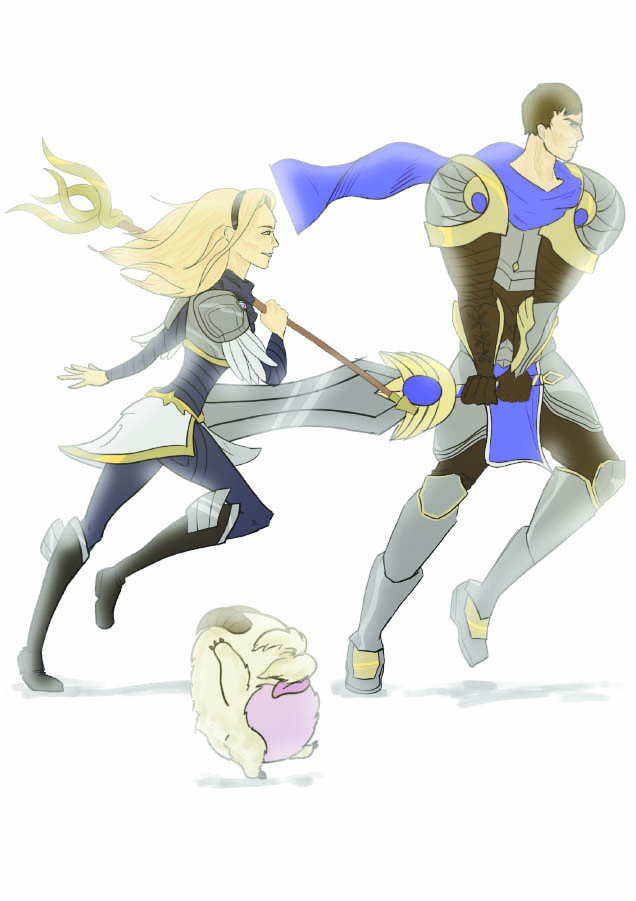
Graphic by Astrid Hernandez | Mercury Staff
Digital card game set in same universe as ‘League of Legends’
Riot Games is finally evolving from Riot Game and creating a
game besides “League of Legends.” They announced two new projects, one of which
is the recently released “Legends of Runeterra.” Riot Games representatives
said that they want to make a card game that improves upon others on the
market, so how does “Legends of Runeterra” stack up to games like “Hearthstone”
and “Magic: The Gathering?”
“Legends of Runeterra” is a new digital card game created by
Riot Games, revealed alongside “Project A” during “League of Legends’” 10-year
anniversary celebration last year. Its mechanics play out similarly to an
altered hybrid of both “Hearthstone” and “Magic: The Gathering,” and while it’s
currently in a beta state, anyone can play it right now. It’s free to play with
in-game purchases, but the monetization is unique in several ways, which is
tied to the game’s unique progression system.
But how does it play? It combines “Hearthstone’s” mechanics
of card health staying constant and max mana increasing on each turn, with
Magic’s mechanics of choosing blockers against attackers, mixed with Riot’s new
mechanics. Unique to “Legends of Runeterra” include the attack token, Champion
level-ups, and the lack of true phases.
In “Legends of Runeterra,” the game progresses round by
round. Each round, one player gets the attack token, meaning that they go first
and can declare an attack on the enemy’s nexus. Turns go back and forth during
a round, and players can summon units or cast spells during their turn, once
per turn. After an attack is declared, the defending player can choose cards to
block, and once the round ends, the attack token goes to the other player.
There isn’t a battle phase that happens at a specific time, as the attack
happens on whatever turn it is declared, and all cards can be played before and
after the attack, if the player has enough mana. When either player’s nexus
(representation of their health) is destroyed, the game ends, averaging about
20 minutes for each game.
Champions are unique cards that come with level-up
conditions and unique abilities, which become central to how a deck is built
and played. For example, a player can build a deck around Yasuo, whose level up
condition is focused around stunning and recalling enemies, by putting as many
cards that stun and recall into the deck as is viable. Stun or recall enough
enemies, and Yasuo levels up, gaining health and attack as well as empowering
his ability. This allows him to attack any enemy when they are stunned or
recalled, giving him free attacks. Every champion in the game has their own
level conditions and abilities, creating multiple viable decks and win
conditions, which is impressive since “Legends of Runeterra” doesn’t have as
many card sets as its competitors. This is one of my favorite aspects of the
game, since it also gives you enough free cards to start experimenting with
most of the champions in the game from the very start.
Compared to other card games, both digital and physical,
cards are more easily obtained without buying booster packs. In fact, it is
literally impossible to buy booster packs: the only monetization gameplay-wise
is directly buying cards. And not only is gambling essentially removed from the
equation, there’s a limited stock of cards players can buy at one time,
reducing the pay-to-win aspect of a game where owning the right cards for a
meta deck can be all that’s necessary to win. The fastest way to earn cards is
legitimately playing the game, which can only take about four hours to be able
to choose common and rare cards. Players can choose a region, which is a
playstyle for a deck, to earn cards for, and can change that region at any
time, meaning that with dedicated playtime, a player can earn more cards than
they can buy.
While the capsules players earn by playing are functionally
booster packs, they will always contain cards for the region the player has
selected, and duplicates convert to currency that can be used to create cards
if not enough wildcards are earned. It’s easy for players to create a deck that
they want to play given about three hours of playtime. Not only is the
progression system friendly for players’ wallets, it also is much more
rewarding than random booster packs or loot boxes, because it gives milestones
to work towards. It works as a positive feedback loop: playing more gets more
cards that players want, which lets players try out new decks and strategies,
incentivizing more play.
While I might be biased as a “League of Legends” player,
“Legends of Runeterra” offers plenty to card game players, from an interesting
gameplay loop that allows for great outplays, to a player-friendly monetization
system that gives creative freedom to players wanting to craft their perfect
deck. Even though it is likely the meta will be solved quickly in the beginning
with its lack of cards compared to older card games, with Riot’s support,
“Legends of Runeterra” can evolve into an even greater experience. As it stands
right now, “Legends of Runeterra” is a great digital card game to compete with
“Hearthstone” and either play a casual game or competitive binge. While a meta
will most likely settle in by the time this article publishes, there’s no
reason to not hop in and experiment with decks in Riot’s new card game experience.